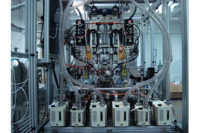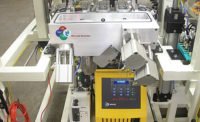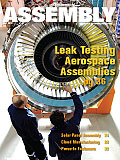
Leaks are never good. They’re even worse if you’re flying in an aircraft at 40,000 feet. That’s why aerospace manufacturers and suppliers spend countless hours testing critical components. Fuel systems, engines, landing gear, ventilation systems and other aerospace devices that rely on numerous tanks, pumps, actuators, lines and fittings must be tested for tightness during both assembly and maintenance applications.
Sometimes, no amount of preparation can prevent pesky leaks from occurring in flight, as engineers at Lockheed Martin Aeronautics Co. recently discovered. The problem-plagued F-35 Joint Strike Fighter program was grounded last month by an oil leak during a test flight in southern California.
Fighters, jetliners, cropdusters, helicopters, satellites, rockets and other things that fly are prone to many types of gas and liquid leaks. They’re also subject to different stresses, atmospheric pressures and quality standards than down-to-earth products such as automobiles, dishwashers and inhalers. That puts unique challenges on aerospace engineers.
“We are dealing with the safety of large amounts of passengers in a black-and-white type of situation,” says Thibault de La Grandville, a sales engineer at ATEQ-Omicron. “Either things go well and you arrive safely, or they go wrong and the consequences can be highly tragic. Things rarely go half right or half wrong in this field and lives are at stake.”
While fuel lines and hydraulic systems are obvious candidates for leak testing, it’s also essential to test cockpit instruments, such as altimeters. If there’s a leak in the circuit, pilots will get an erroneous reading of altitude, speed or rate of climbing.
“At every stage [of aerospace assembly] everything needs to be checked with the utmost care,” de La Grandville points out. “The pressure to deliver a reliable product is very high. Safety comes before cost more in aerospace than in any other industry.”
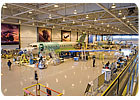
Leak detection is an important part of aircraft manufacturing. Photo courtesy Bombardier
Stringent Standards
That’s why aerospace manufacturers require high levels of quality certifications with leak testing equipment, such as ISO 9001 and AS9100, in addition to safety certifications, such as UL 913. Many companies are also subject to stringent standards, such as MIL-STD-750, Method 1071, which covers hermetic seals, and IP67, which covers leaktight enclosures.“The specifications for aerospace can be tighter than some other industries,” says Martin Bryant, vice president of sales and marketing at Uson LP. “Aerospace manufacturers require high traceability and, therefore, leak testers and systems should be able to comply with data collection and part identification requirements such as bar code, 2D matrix or RFID reading.”
“Aerospace leak testing is similar to the medical industry, but compared to automotive, it is slower to change procedures,” adds Dave Morris, marketing manager at Alcatel Vacuum Products. “Aircraft or systems onboard aircraft are [often] tested manually. Smaller components are more automated, but compared to the automotive industry, batch sizes are quite small.”
Manufacturers and suppliers are often held to a higher standard. They’re also subject to random spot checks and various red tape related to International Traffic in Arms Regulations.
“This industry is required to adhere to military standards, which mandate a tremendous amount of records keeping and data retention,” says Chris Goebel, senior director of component sales and marketing at ULVAC Technologies Inc. “Aerospace is more demanding and asks more questions than any other industry we work with. When we’ve been working on projects for NASA, people from the FBI have arrived at our door, unannounced, to check records.”
Smaller production volumes and throughput speeds also set aerospace apart from other industries. Traditionally, aerospace manufacturers move at a leisurely pace. In sharp contrast, automotive fuel lines, radiators, brake lines and other components typically need to be tested in 20 to 30 seconds per part. Some disposable medical devices must be tested even faster-as quickly as one part every 2 seconds.
“The typical medical device manufacturer makes thousands of parts a day,” says Gordon Splete, account development manager at Cincinnati Test Systems Inc. “On the other hand, a helicopter manufacturer may be assembling just one vehicle a week. A company making fuel pumps for aerospace applications might only assemble 2,000 a year; an automotive supplier might build 2,000 units daily or weekly.
“Production rate wise, certain components may have less throughput requirements in aerospace compared to automotive,” adds Splete. “This allows more time for testing and for considering technologies to be used in the production timeframe allowed. Low production rates allow some manual intervention with the parts, rather than fully automated processes.”
Smaller production volumes can also pose bigger leak testing challenges. “It’s unlike the automotive sector, where you are talking about thousands or millions of parts per year in volume, and leak testing systems can be afforded,” notes Kent Schien, CEO of Innoventor Inc., a design-build engineering firm that has worked on numerous aerospace leak-testing applications.
“The aircraft industry only has [to test] hundreds or dozens of parts per year,” Schien points out. “It’s even less in the spacecraft sector; maybe only one or two parts annually. Therefore, standardization is difficult.”
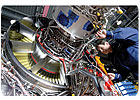
Jet aircraft engines are a potential source of many types of leaks. Photo courtesy Rolls-Royce
Size Matters
Most aerospace parts are larger and heavier than automotive and medical components. Pumps and other hydraulic components typically operate under higher pressure and are physically larger than devices used for automotive application.That poses some leak testing challenges. For instance, it’s hard to put a jet engine or a landing gear in a test chamber. As a result, most testing usually occurs during subassembly instead of final assembly.
“Our customers are leak checking components, such as fittings and bellows, rather than complete systems,” says Steve Blair, product manager for leak detection and gauges at Pfeiffer Vacuum Inc.
“Everything is unique in aerospace,” adds Splete. “The hardest parts to test are those with irregular shapes and seal surfaces, such as fuel lines and landing gear.”
Aerospace manufacturers often prefer test systems mounted on carts for portability. “They typically bring the instrument to the component, because of size and weight restrictions,” notes Jacques Hoffmann, president of InterTech Development Co. “In automotive and medical device applications, you bring the part to the leak testing equipment.”
“Larger components, such as landing gear and ventilation systems, offer challenges due to their size,” adds Goebel. “That requires unique leak detection methods, such as using sniffer probes. Smaller, hermetically sealed electronic components are [often] tested using automatic leak testing systems.”
The aerospace industry uses a wide variety of leak testing equipment and methods. “Helium and hydrogen are typically used when testing large volumes, such as fuel tanks,” says Hoffmann. “Actuators and other components use hydraulic testing.”
The types of testing methods used are often dictated by the test measurement criteria, such as flow rate and pressure, and the type of part to be tested. “Pressure decay or vacuum decay testing methods are used for leak rates of 1 standard cubic centimeter per minute (sccm) and higher,” says Splete. “That’s typically used for pumps and fluid devices, and for radio enclosures that undergo atmospheric changes.
“When approaching high flow rates, such as measurements between 100 and 1,000 sccm, then mass flow testing is considered,” adds Splete. “Helium mass spec testing methods are used when leak rates are lower than 0.5 sccm, such as high-pressure fuel lines and oxygen systems.
“We still see some bubble testing in the aerospace industry,” Splete points out. But, many manufacturers are moving toward more sensitive methods that use helium and hydrogen tracer gases.
“Trace gas-helium, hydrogen and even sulfur hexafluoride-seem to be more popular in the aerospace industry than in others,” explains Bryant. “This is due to specifications and production volumes which permit longer test cycle times.”
According to Alcatel’s Morris, “leak detection on aircraft fuel systems can be very tricky. The leak entry point inside the tank is often far away from the leak exit point on the outside of the aircraft. Tracer gas leak detection is the fastest and most reliable way to find and repair the leak by back-tracing the gas.”
As a rule of thumb, the larger the aerospace part, the more intricate it is inside. And, the higher the pressure, the more difficult it is to test the part. For example, a wing can be challenging to pressurize. Because it has different compartments, it is difficult to ensure that all the parts are actually pressurized at the same rate.
“For such parts, pressure decay is almost impossible to use, because no instrument in the world can detect minute leaks on a large volume,” explains ATEQ-Omicron’s de La Grandville. “On a 1,000 liter part, for example, the minimum leak that you could detect with a pressure decay instrument would be 600 sccm. This test is not reliable for a large fuel reservoir. In that case, we use a hydrogen sniffer. But, since the part has a large surface, you have to really sniff it thoroughly.
“Landing gear, on the other hand, offers another challenge,” adds de La Grandville. “To test hydraulic parts, you have to test them at their working pressure, which is very high. With such high testing pressures, you have to be very careful when you build your testing jig in order to avoid [explosions and other] accidents.”
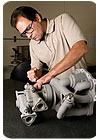
Aircraft fuel pumps must be checked for leaks. Photo courtesy Eaton Corp.
Leaks in Space
Spacecraft present even bigger challenges to aerospace engineers. For instance, companies that manufacture space instrumentation, satellites and other devices have to subject their products to a battery of prototyping, flight qualification and flight verification phases.“Before launch, the products must experience space-like temperatures and vacuum levels, and be shown not only to survive the extreme ranges, but also to operate within specification before, during and after,” says Margaret Bishop, business development manager at Abbess Instruments. “Space simulation chambers are key to these tests.” The custom-built equipment simulates launch-to-space pressures, focusing on space vacuums at altitudes above 100,000 feet.
Innoventor also works on out-of-this-world leak testing applications. For instance, it recently designed a one-of-a-kind helium leak test system for Boeing’s launch vehicle facility in Decatur, AL. The automated system tests 110 different locations on the Delta IV upper stage propulsion system, which carries heavy payloads, such as satellites, into orbit.
“We developed a helium mass-flow detection system that [allows] the upper propulsion system portion to function at maximum operating pressure,” explains Schien. “Using a dual vacuum system design and a mass spectrometer, it can measure individual helium leaks in 15 to 20 seconds.” The device reduced a 16 to 20 hour test cycle to less than 1 hour.
“As technology advances both in heavy lift capability in the aerospace sector and the higher usage of technology in the automotive sector, the technologies for leak testing are converging,” notes Schien. “New aircraft systems are using more and more automation in leak testing.
“For example, Boeing’s 787 program utilizes much more automation than any past programs,” Schien points out. “The ultimate end goal [for the aerospace industry] is a universal system that could test and give back quantifiable data of a component, a subsystem or a system.” A

